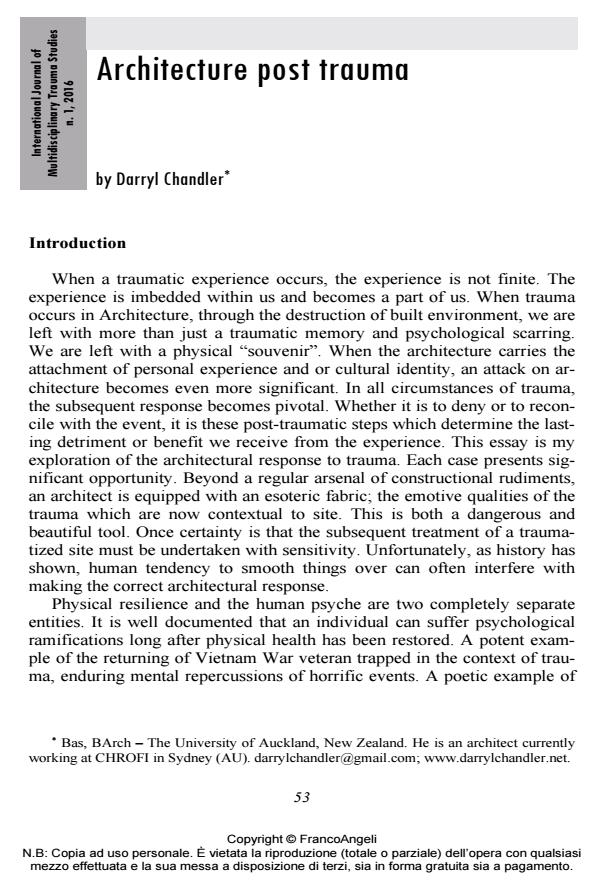Architecture post trauma
Titolo Rivista INTERNATIONAL JOURNAL OF MULTIDISCIPLINARY TRAUMA STUDIES
Autori/Curatori Darryl Chandler
Anno di pubblicazione 2016 Fascicolo 2016/1
Lingua Inglese Numero pagine 8 P. 53-60 Dimensione file 174 KB
DOI 10.3280/IJM2016-001006
Il DOI è il codice a barre della proprietà intellettuale: per saperne di più
clicca qui
Qui sotto puoi vedere in anteprima la prima pagina di questo articolo.
Se questo articolo ti interessa, lo puoi acquistare (e scaricare in formato pdf) seguendo le facili indicazioni per acquistare il download credit. Acquista Download Credits per scaricare questo Articolo in formato PDF

FrancoAngeli è membro della Publishers International Linking Association, Inc (PILA)associazione indipendente e non profit per facilitare (attraverso i servizi tecnologici implementati da CrossRef.org) l’accesso degli studiosi ai contenuti digitali nelle pubblicazioni professionali e scientifiche
When trauma occurs in architecture it leaves more than a traumatic memory and psychological scarring. In fact, when a traumatic experience occurs, the experience is not finite and it is imbedded within us and becomes a part of us. The architecture carries the attachment of personal experience and or cultural identity, an attack on architecture becomes even more significant. In all circumstances of trauma, the subsequent response becomes pivotal. Whether it is to deny or to reconcile with the event, it is these post-traumatic steps which determine the lasting detriment or benefit we receive from the experience. This essay is my exploration of the architectural response to trauma as each case, also examined in this paper, presents significant opportunity as a "future memory".
Quando si verifica un trauma in architettura, questo lascia più di un ricordo traumatico e cicatrici psicologiche. Infatti, quando si verifica un’esperienza traumatica questa non è finita implicando diverse percezioni e diventa parte di noi. L’archi¬tettura implica un attaccamento riferito all’esperienza personale che diventa parte della propria identità anche culturale. Per questo un attacco contro l’architettura di un popolo diventa ancora più significativo. In tutte le situazioni traumatiche, la risposta successiva diventa fondamentale. Sia che si tratti di negare o assimilare l’evento, saranno i passi post-traumatici a determinare il danno - durevole o transitorio - che riceviamo da questa esperienza. Questo contributo è la mia esplorazione della risposta architettonica a traumi dato che ogni caso, esaminato anche in questo lavoro, presenta significative opportunità di riflessione a futura memoria.
Parole chiave:Architettura post-traumatica, trauma, memoria culturale.
- AA.VV. (1950). A-Bomb resistant buildings. Architectural Forum, 93.
- Azadzoi I. (2003). Rebuilding Afghanistan. Urban Land, 62(3): 62-68.
- Bernstein F. (2004). 3 years later. Architectural Record, 192(12):25
- Bevan R. (2006). Destruction of Memory. London: Reaction Books.
- Dickenson J.S. (2002). Move – Sites of trauma. Pamphlet Architecture 23. NY: Princeton Press.
- Dornell E. (2002). Foster and Libeskind make final to rebuild WTC. Architects Journal, 216 (3).
- Fraser M. (2003). Upstart. RIBA, 110(1):30-40.
- Kugel C. (2002). Letting in the Light. Architecture Review, 212(1228):64-67.
- MacDonald S. (2003). Remember the past, think of the future. Blueprint, 204
- Masaaki T. (2003). Love in Ruins. Blueprint, 205:68-74.
- O’Brien T. (1990). The things they carried. Houghton Miffling Harcourt, US.
- Pallasmaa J. (2000). Hapticity and Time. Notes on a fragile architecture. The Architectural Review, 207(1239):78-84.
- Pedersen M. (2005). Bringing back the big easy. Metropolis, 25(4):126-130.
- Sinclair C. and Stohr K. (Eds.) (2006). Design like you give a damn: architectural responses to humanitarian crisis. London: Thames & Hudson.
- Stephens S. (2004). Imagining Ground Zero. NY: Rizzoli International Publications inc.
- van der Hoorn M. (2002). Injection in a Nazi Ruin: the Party Rally Grounds Documentation Centre at Nuremberg. Archis, 3:108-115.
- Woods L. (1993). War and Architecture. Pamphlet architecture 15. NY: Princeton Press.
Darryl Chandler, Architecture post trauma in "INTERNATIONAL JOURNAL OF MULTIDISCIPLINARY TRAUMA STUDIES" 1/2016, pp 53-60, DOI: 10.3280/IJM2016-001006